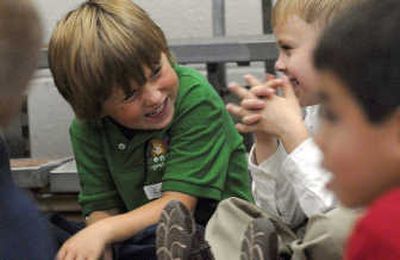Magnet school a real draw

On the surface, the first day of school at Sorensen Magnet School mirrored the first day at Coeur d’Alene’s nine other elementaries.
Enthusiasm and anxiety filled the building as students found their classrooms. Teachers directed traffic. Kindergartners not yet versed in walking single file clung to a rope as their teacher led them down the hallway. Parents milled about, cameras in hand.
But to people like Rebecca Memmer and her 5-year-old daughter Holland, Tuesday was the first step in a new and unique venture. Memmer lives in Post Falls but said the idea of a school that specialized in the arts and humanities – and welcomes students from outside the district – encouraged her to look to Sorensen in the downtown Coeur d’Alene area for her daughter.
“I feel like maybe this is a place where she can be a kid and learn,” Memmer said. Holland is one of about 80 students who came to Sorensen from outside the Coeur d’Alene district.
Headed for closure last school year, Sorensen has become one of the most sought-after public education options in North Idaho. The building is filled with about 315 students, and more than 50 were turned away through a lottery system. The huge response stunned district administrators and prompted discussion of creating more choices in the Coeur d’Alene School District.
“It really underscores for me this pent-up desire for choice,” said Hazel Bauman, assistant superintendent. “We know children aren’t cookie-cutters. They’re all different, so why would a one-size-fits-all school system work?”
Bauman and other district officials talked with state Superintendent of Public Instruction Tom Luna and state Senate Education Committee Chairman John Goedde, R-Coeur d’Alene, Tuesday about the push for more choice in public education. Luna toured Sorensen, ate with students and watched a promotional video about the magnet school.
Already, differences in how the school operates were clear. The uniform policy – khaki pants, shorts or skirts and a polo shirt with the Sorensen logo – bid adieu to the hallway fashion show. Kids juggled in the gym during lunch. The school’s first outside artist, Terrie Kralik from Sagle, will visit today to help kids make self portraits out of fabric.
“We want to make a statement that we are interested in really doing things differently,” Principal David Miller said.
School staff began planning for a magnet school about three years ago. The threat of closure to save money brought it to the forefront, and the support from the community ultimately saved the school, Miller said.
Staff attended a conference in southern Idaho this summer on arts-oriented curriculum. And Sorensen joined Hayden Meadows and Fernan elementary schools as the Coeur d’Alene district’s applicants to become International Baccalaureate schools.
The international “primary years program” curriculum uses foreign language and encourages the kind of critical thinking in students that the magnet school concept hopes to promote, Miller said. The training that comes with the program will help mold the magnet school’s curriculum.
“It’s not that we’re emphasizing art curriculum,” said counselor Hilary Banger. “It’s that we’re enhancing our curriculum through the arts.”
Staff agreed to extend the school day by 45 minutes to give more time for the arts focus. The weekly schedule has blocks for reading, math, science and social studies. But students also will spend 20 minutes per week learning Spanish. Fourth- and fifth-graders have an hour twice a week for demonstrations from teachers, community members and visiting artists.
Even the lunch break will have an arts focus. Students will spend part of the time doing an organized activity, like juggling, before heading to the playground. Fifth-grade teacher David Groth has used juggling in his classroom since he started at Sorensen about 10 years ago. He attended a training session this summer on ways to integrate music into math lessons and plans to put more emphasis on public performance in his class.
Students did a lot of that Tuesday afternoon. After Luna and district officials ate lunch with students, Groth introduced him to fifth-grader Parker Gabrielson. On cue, the boy threw three yellow and black balls in the air and juggled them in front of the group. But Luna had his own trick: he juggled a few times before heading out to a classroom.
How will school staff know their school is successful? Test scores are one factor, but, said Groth, “A huge one for me will be ‘What are the kids saying when they come home from school?’ “
“One of the best ways to measure kids is to help them learn to measure themselves,” Miller said.
Students have time for that in their schedules: 15 minutes, four mornings a week, is dedicated to students reflecting on their accomplishments through writing or group activities. And all students will gather twice a week, Monday morning and Friday afternoon, to plan for the coming week, reflect on the past and perform for each other.
“Immersion days” that bring in substitute teachers and community members to hold schoolwide lessons on subjects such as writing, nature and painting will happen about once a month, giving staff a chance to get together and assess how things are going.
Miller said he heard from many parents new to the school that they were tired of the structured focus on improving test scores that they see public schools embracing.